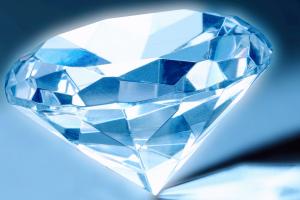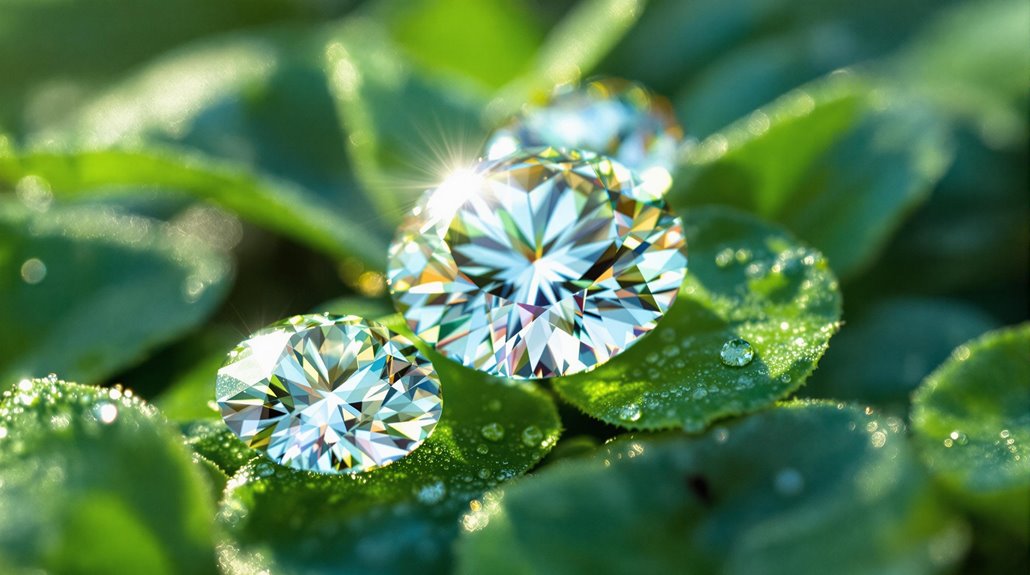Article Contents
- 1 Main Highlights
- 2 Frequently Asked Questions
- 2.1 How Do Lab-Grown Diamonds Compare to Mined Diamonds in Terms of Resale Value?
- 2.2 Can I Upgrade My Sustainable Diamond to a Larger One Later?
- 2.3 Are Sustainable Diamonds Covered by Jewelry Insurance Policies?
- 2.4 Do Sustainable Diamonds Come With the Same Certification as Traditional Diamonds?
- 2.5 How Long Does It Take to Create a Lab-Grown Sustainable Diamond?
Sustainable diamonds offer ethically conscious consumers two primary alternatives: lab-grown stones, which are molecularly identical to mined diamonds, and recycled jewels sourced from vintage pieces. These choices significantly reduce environmental impact, with lab-grown diamonds eliminating extensive mining operations and recycled stones contributing to a circular economy. The market for sustainable diamonds continues to grow, driven by rigorous certification processes and increasing consumer demand for responsible luxury. This modern approach to fine jewelry opens new possibilities in conscious adornment.
Main Highlights
- Lab-grown diamonds offer identical quality to mined diamonds while significantly reducing environmental impact and water consumption.
- Independent certification ensures sustainability standards are met through rigorous assessments and transparent sourcing practices.
- Recycled diamonds from vintage pieces provide an eco-friendly option while contributing to the circular economy.
- Sustainable diamond producers invest in renewable energy and advanced technologies to minimize ecological footprint.
- Consumer demand for ethical diamonds drives industry improvements in fair labor practices and environmental protection.
As consumers become increasingly aware of their environmental footprint, the choice between traditional and sustainable diamonds has emerged as a pivotal consideration in luxury purchases. The modern diamond market offers sophisticated substitutes that align with both environmental values and aesthetic desires.
Lab-grown diamonds, scientifically identical to their mined counterparts, represent a groundbreaking advancement in sustainable luxury, offering the same brilliance and durability during significant reductions in environmental impact. These creative jewels eliminate the need for extensive mining operations, thereby preserving natural habitats and reducing carbon emissions associated with traditional diamond extraction. Consumer awareness and demand have driven unprecedented transparency in diamond sourcing practices. The market for these sustainable gems has shown remarkable growth, with lab-grown diamond sales expected to reach $5 billion by 2027. Advanced technologies like FTIR spectroscopy are employed to ensure authenticity and quality of lab-grown diamonds.
Each sustainable diamond undergoes rigorous ethical requirements through independent assessment to ensure complete compliance with industry standards. For those pursuing a connection to history while maintaining environmental consciousness, recycled diamonds present an elegant solution. These carefully curated stones, often sourced from vintage pieces and family heirlooms, carry unique stories while contributing to a circular economy. By choosing recycled diamonds, discerning buyers participate in a sophisticated form of conservation, preventing the need for additional mining while preserving the timeless appeal of these precious jewels.
The integrity of sustainable diamonds is upheld through rigorous certification processes and industry standards. Organizations such as SCS Global Services provide thorough assessments, guaranteeing that sustainability-rated diamonds meet strict environmental and ethical criteria. Traditional mining requires 126 gallons of water per carat, making sustainable alternatives increasingly attractive. The Kimberley Process, although focusing primarily on preventing conflict diamonds, has established a foundation for traceability in the diamond industry, complementing newer sustainability initiatives.
The diamond industry's evolution toward sustainability reflects a broader commitment to environmental stewardship and ethical practices. Progressive producers are investing in renewable energy solutions and implementing advanced technologies to minimize their ecological impact.
This transformation extends beyond environmental considerations to encompass fair labor practices and community development, creating a more responsible and transparent industry ecosystem.
Environmental consciousness in diamond selection has become a hallmark of refined taste and social responsibility. Whereas traditional mining practices have historically contributed to habitat disruption and carbon emissions, sustainable substitutes offer a path forward that honors both luxury and conservation.
The growing preference for sustainable diamonds among discerning consumers has sparked industry-wide improvements in ethical sourcing and environmental protection.
The movement toward sustainable diamonds represents more than a trend; it embodies a fundamental shift in how luxury is defined and acquired. Through careful selection of certified sustainable diamonds, whether lab-grown or recycled, consumers participate in an enhanced form of conscious consumption.
This thoughtful approach to diamond acquisition guarantees that each piece not just captures the desired aesthetic but also reflects a commitment to environmental stewardship and ethical practices, establishing a new standard for luxury that resonates with contemporary values.
Frequently Asked Questions
How Do Lab-Grown Diamonds Compare to Mined Diamonds in Terms of Resale Value?
Lab-grown diamonds have significantly lower value retention in the resale market compared to mined diamonds, typically retaining minimal value whereas natural diamonds can maintain up to 50% of their original price.
Can I Upgrade My Sustainable Diamond to a Larger One Later?
Like evolving a cherished heirloom, most jewelers offer diamond upgrade choices for sustainable stones. During resale values vary, many retailers provide trade-in programs to help offset costs of sizing up.
Are Sustainable Diamonds Covered by Jewelry Insurance Policies?
Sustainable diamonds receive insurance coverage from most reputable providers, with choices ranging from specialized jewelry policies to homeowners insurance riders. Standard policy limitations apply, similar to natural diamond coverage.
Do Sustainable Diamonds Come With the Same Certification as Traditional Diamonds?
Sustainable diamonds follow identical certification standards and diamond grading processes as traditional diamonds. Leading organizations like GIA and AGS certify both types using the same thorough evaluation criteria and documentation.
How Long Does It Take to Create a Lab-Grown Sustainable Diamond?
During traditional diamonds take millions of years, lab diamond technology can create jewels in days to weeks, with the diamond growth process ranging from 2-19 days depending on size.

